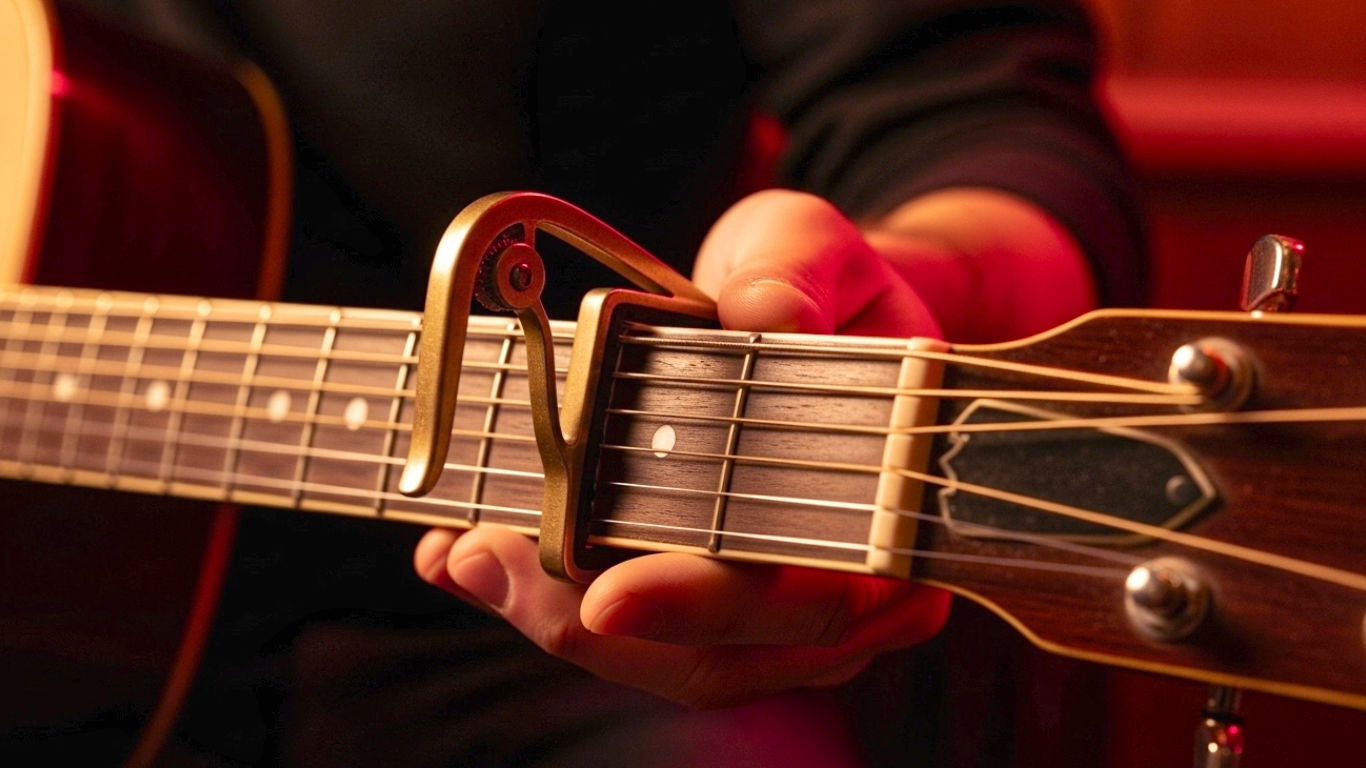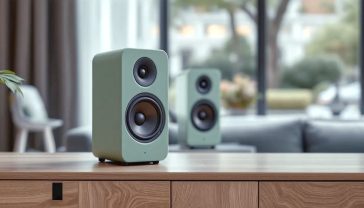The Guide to the Guitar Capo: Your Secret Weapon for Sound
This definitive guide covers everything about the guitar capo, from its history to advanced techniques, with practical tips for UK guitarists.

This post may contain affiliate links. If you make a purchase through these links, we may earn a commission at no additional cost to you.
Picture the scene. It’s the mid-90s, and a song comes on the radio that will define a generation of British music. It starts with four simple, ringing chords. It’s the sound of Oasis’ “Wonderwall,” and it’s a sound that thousands of aspiring guitarists would try to copy in their bedrooms. They’d look up the chords—Em, G, D, A—and strum away, only to find it sounded… well, a bit flat. A bit wrong.
The secret wasn’t some complicated tuning or a fiendishly difficult chord shape. It was a small, simple clamp placed on the second fret of Noel Gallagher’s guitar. That little gadget is a guitar capo, and it’s one of the most powerful, yet often misunderstood, tools in a guitarist’s arsenal.
From George Harrison’s beautiful acoustic work on The Beatles’ “Here Comes the Sun” to the intricate folk patterns of Joni Mitchell and the modern acoustic anthems of Ed Sheeran, the humble capo is everywhere. It’s a secret weapon that can transform your playing, make difficult songs easy, unlock new sounds from your instrument, and, most importantly, help you find the perfect key for your voice.
But what exactly is it? How does it work? Which one should you buy? And how do you use it without making your guitar sound like a bag of spanners?
Don’t worry. This is your ultimate guide. We’ll cover everything from the absolute basics to advanced creative techniques. By the end, you’ll see the capo not as a cheat, but as an essential tool for creativity and expression. Let’s get started.
What on Earth is a Capo, and How Does It Work?
At its heart, a capo is a very simple device. It’s a clamp that you attach to the neck of your guitar, pressing down on all the strings at a particular fret. Think of it as a moveable finger that can hold down all the strings at once, perfectly.
The Simplest Explanation: A Moveable Nut
The easiest way to understand a capo is to think of it as a moveable nut.
Look at the very top of your guitar’s neck, near the headstock where the tuning pegs are. You’ll see a small, grooved strip of plastic, bone, or metal that the strings pass over. This is called the nut. The nut is the starting point for the vibrating length of your open strings. When you play an open E string, the string vibrates between the nut and the bridge (the part on the guitar’s body where the strings are anchored).
When you place a capo on, say, the third fret, that capo now becomes the new nut. It effectively shortens the vibrating length of all the strings. The open strings are now three frets higher in pitch, and the part of the neck between the capo and the headstock is ignored.
You can still play all the same chord shapes you know and love (like G, C, and D), but because the starting point has moved up the neck, they will sound in a higher key. It’s that simple.
The Technical Bit: How It Changes the Pitch
Music is all about pitch, and on a guitar, each fret represents a half-step, or a semitone. If you play a note on a string and then move your finger up one fret, the note is now one semitone higher.
The capo does this for all the strings at the same time.
- Capo on the 1st fret: Everything is one semitone (a half-step) higher.
- Capo on the 2nd fret: Everything is two semitones (a whole step) higher.
- Capo on the 3rd fret: Everything is three semitones (one and a half steps) higher.
And so on. So, if you play a G chord shape with the capo on the 2nd fret, you’re not actually hearing a G chord. You’re hearing a chord that is two semitones higher than G, which is an A chord. You’re playing a G shape, but the sound coming out is A. This concept, called transposition, is the capo’s superpower.
Why Bother Using a Capo? The Three Main Reasons
So, why not just learn the new chords in the higher key? Why not just play an A barre chord instead of using a capo to make your G shape sound like an A? It’s a fair question, and there are three brilliant answers.
Reason 1: Making Life Easier for Singers (Transposition)
This is the number one reason most people reach for a capo. Every singer has a vocal range where their voice sounds best—not too low and croaky, not too high and strained. Sometimes, the original key of a song just doesn’t fit a singer’s voice.
Imagine you want to sing a song that uses the chords G, C, and D. It sounds great, but it feels a bit too low for your voice. You need to raise the key. You could try to play it in A, using the chords A, D, and E. That’s easy enough.
But what if the best key for your voice is B-flat? Suddenly, you’re wrestling with tricky barre chords like Bb, Eb, and F. It’s a nightmare for a beginner and frankly, a bit of a faff for anyone.
With a capo, it’s a piece of cake. You just put the capo on the 3rd fret and play your comfortable G, C, and D shapes. The actual sound will be in B-flat, your voice will feel amazing, and you can focus on the performance instead of a painful F barre chord. The capo lets you change the key of a song without changing the chord shapes you play.
Reason 2: Unlocking New Sounds and Tones (Timbre)
A guitar doesn’t sound the same all over the neck. Chords played with open strings have a unique, ringing quality that you lose when you start using barre chords. A capo helps you keep that beautiful, jangly sound in different keys.
Think about it: when you play a G chord, you have three open strings (D, G, and B) ringing out. When you play a G barre chord at the third fret, none of the strings are open. It sounds fine, but it’s a bit chunkier, a bit more contained.
Now, place a capo on the 3rd fret and play an E chord shape. The actual key you’re in is G, but you’re getting the sound of the open strings from the E shape. This creates a brighter, chiming tone that you simply can’t get from a standard G barre chord. This is why artists like Johnny Marr from The Smiths used a capo so often—to get those signature bright, jangly guitar lines. It changes the timbre (the tonal character) of the guitar.
Reason 3: Dodging Those Dreaded Barre Chords (Ease of Playing)
Let’s be honest, barre chords are hard work. They take time to master and can tire your hand out. A capo can be a brilliant workaround, especially for beginners or for songs that are full of them.
Take a song like “Hotel California” by The Eagles. The iconic intro is played with a capo on the 7th fret. Without it, you’d be playing a series of very awkward barre chords high up the neck. With the capo, you’re just using simple, open-position chord shapes like Am, E7, G, and C.
It’s not cheating; it’s just a smarter way to play the part. It allows for the fluid, elegant fingerpicking that makes the song so recognisable. The capo makes the impossible, possible.
A Trip Through Time: The Surprising History of the Capo
The idea of shortening strings to change their pitch isn’t new. For centuries, musicians have used various methods to achieve this. The word “capo” itself comes from the Italian capo tasto, which means “head of the fretboard.”
Early versions, dating back to the 18th century, were often simple blocks of wood or ivory, tied to the neck with a piece of string or a leather strap. They were crude but effective.
The first major leap forward came in the United States. In 1850, a man named James Ashborn of Wolcottville, Connecticut, filed a patent for a modern-style capo with a lever and a spring to adjust the tension. This was a game-changer, allowing for much quicker and more reliable key changes.
Throughout the 20th century, as the guitar became a dominant force in popular music, inventors and companies refined the design, leading to the huge variety of capos we see today. From simple elastic straps to precision-engineered works of art, the core principle has remained the same: to be a simple, reliable, moveable nut.
Know Your Kit: A Deep Dive into the Different Types of Capo
Walking into a music shop (or browsing online) can be confusing. There are dozens of different capo designs, all claiming to be the best. In reality, they mostly fall into a few main categories, each with its own pros and cons.
The Spring-Loaded (Trigger) Capo: Quick and Easy
This is probably the most common type of capo you’ll see. It looks a bit like a large, powerful clothes peg. You use one hand to squeeze the “trigger,” which opens the clamp, place it on the neck, and release.
- How it works: A spring provides the tension to hold the strings down.
- Pros: Very fast and easy to use with one hand. You can quickly move it between songs during a live gig. They are relatively affordable and widely available. The Kyser Quick-Change is the classic example.
- Cons: The biggest drawback is the lack of adjustable tension. The spring is set at one strength, which can sometimes be too strong, pulling the strings slightly sharp and sending your guitar out of tune.
- Best for: Gigging musicians who need to change keys quickly on stage.
The Screw Capo: Precision and Control
This design uses a small screw mechanism that you tighten to apply pressure to the strings. It offers far more control than a trigger capo.
- How it works: You place the capo on the neck and turn a small knob or screw until you have just enough pressure to hold the strings down cleanly.
- Pros: Adjustable tension! This is the key benefit. You can apply the minimum pressure needed, which means your guitar is much more likely to stay in tune. They are often smaller and less bulky than trigger capos. A popular example is the D’Addario/Planet Waves NS Capo.
- Cons: They are slower to put on and move than a trigger capo, usually requiring two hands. This makes them less ideal for rapid changes during a live set.
- Best for: Studio recording, practice, and anyone who prioritises perfect tuning over speed.
The Yoke-Style (Shubb) Capo: The Studio Favourite
This type of capo wraps around the back of the neck and clamps down from behind. It’s a classic design, beloved by many professional musicians for its reliability and tuning stability. The design is often associated with the Shubb brand, a true industry standard.
- How it works: A lever on the back flips to lock the capo in place, and a small screw allows you to fine-tune the tension. It combines the precision of a screw capo with the relative speed of a lever.
- Pros: Excellent, even pressure across the strings. Once you set the tension for your guitar, you can take it on and off quickly without readjusting. They are very stable and reliable.
- Cons: They can be a bit more expensive and slightly more fiddly to set up initially compared to a trigger capo. You also can’t just clip it to your headstock when not in use.
- Best for: Serious players, studio work, and anyone who wants a ‘set it and forget it’ solution for perfect tension.
The Toggle Capo: The Budget-Friendly Option
This is a very simple design featuring a padded bar and a serrated strap with a lever that you click into place.
- How it works: You wrap the strap around the neck and flip the toggle to one of several positions to create tension.
- Pros: They are incredibly cheap and lightweight. A good choice if you’re on a tight budget or just want a spare to throw in your guitar case.
- Cons: The tension is not very adjustable, and the pressure can be uneven, often leading to tuning problems or fret buzz. They aren’t very durable.
- Best for: Absolute beginners on a budget, or as an emergency backup.
The Weird and Wonderful: Partial and Spider Capos
For the more adventurous guitarist, there are capos that don’t cover all six strings.
- Partial Capos: These are designed to hold down only some of the strings (e.g., three, four, or five). This creates amazing alternate tunings without you having to touch the tuning pegs. It’s like having an extra finger with an impossibly long reach. Folk and acoustic fingerstyle players like James Taylor love these for creating unique, droning sounds.
- Spider Capos: This is even more advanced. A spider capo has individual levers for each string, allowing you to choose exactly which strings to fret and which to leave open at any given position. It’s a tool for serious experimentation.
A Special Mention: G7th – The British Innovators
It would be wrong to talk about capos without mentioning G7th, a brilliant British company that has pushed capo design forward. Their flagship Performance capo combines the speed of a spring-loaded design with the subtle control of a screw capo. You simply squeeze it to the desired pressure, and it locks in place. Their Newport and Heritage models are also highly regarded yoke-style designs. They represent the peak of modern capo engineering and are a great example of British innovation in the music world.
How to Choose the Perfect Capo for You and Your Guitar
With so many options, how do you pick the right one? Here are the key things to consider.
Matching the Capo to Your Guitar
The most important factor is the shape of your guitar’s fretboard, known as the radius.
- Classical Guitars: Have a completely flat fretboard. You need a capo designed for classical guitars, with a flat padded bar. Using a curved capo will result in buzzing and tuning issues.
- Steel-String Acoustic and Electric Guitars: Most of these have a curved fretboard (a radiused fretboard). You need a standard capo with a curved pad.
Some capos, especially more expensive yoke-style ones, come with interchangeable pads to match different fretboard radii perfectly. For most players, a standard curved capo will work fine on their acoustic or electric guitar.
Your Playing Style: Live Gigging vs. Studio Recording
- If you play live and need to switch keys in a hurry between songs, a trigger capo like a Kyser is hard to beat for speed and convenience.
- If you primarily play at home or record in a studio, tuning accuracy is paramount. A screw or yoke-style capo (like a Shubb or G7th) will give you the precise tension control you need to keep your guitar perfectly in tune.
Budget: How Much Should You Spend?
- Under £10: You’ll find basic toggle capos and some cheaper trigger-style clones. They’ll get the job done, but don’t expect perfect tuning stability.
- £15 – £25: This is the sweet spot. Here you’ll find the legendary Kyser Quick-Change, the excellent Shubb C1, and the D’Addario NS. For most players, a capo in this price range is a fantastic investment that will last for years.
- £30+: This is the territory of premium capos, like those from G7th. The engineering, materials, and tuning stability are top-notch. If you are a serious musician or just appreciate beautifully made kit, they are worth every penny.
The Art of Using a Capo: A Step-by-Step Guide to Perfect Pitch
Owning a great capo is only half the battle. Using it correctly is the key to avoiding frustration and staying in tune.
Step 1: Placement is Everything
This is the most common mistake people make. A capo should be placed just behind the fret wire, not directly on top of it or in the middle of the fret.
Imagine the fret you want to capo is the 3rd fret. You should place the capo in the space between the 2nd and 3rd frets, but as close to the 3rd fret as possible without touching it.
- Why? This requires the least amount of pressure to get a clean, buzz-free sound. If you place it in the middle of the fret, you’ll need to clamp down much harder, which will pull the strings sharp.
Step 2: Getting the Tension Just Right
The golden rule of capo tension is: use the minimum amount of pressure required to get a clear sound from all strings.
- With a screw or yoke capo, this is easy. Tighten it until each string rings out clearly when you pluck it. If you hear a buzz, it’s too loose. If it sounds clear, stop tightening. Any more is too much.
- With a trigger capo, you don’t have this control. This is why their placement is even more critical to minimise tuning problems.
Step 3: The All-Important Tuning Check
Even with perfect placement and tension, a capo can slightly affect your tuning. Always give your guitar a quick tune-up after you’ve put the capo on.
You don’t need to go back to the headstock and start cranking the tuning pegs wildly. Often, it’s just a tiny adjustment. Use an electronic tuner and check each string. You’ll be amazed at the difference this small step makes.
Common Capo Catastrophes and How to Avoid Them
Here are the most common problems people face with capos and how to solve them.
The Dreaded ‘String Bend’: Why Your Guitar Sounds Out of Tune
The Problem: You put your capo on, play a lovely G chord, and it sounds horribly sharp and out of tune.
The Cause: This is almost always caused by too much tension or poor placement. The capo is literally bending the strings over the fret, stretching them and making their pitch sharp.
The Fix:
- Check your placement. Make sure the capo is right up against the back of the fret wire.
- Reduce the tension. If you have an adjustable capo, loosen it to the bare minimum needed for a clean sound.
- Check your guitar’s setup. If your guitar has very high action (the strings are far from the fretboard), it will be more prone to going sharp when you use a capo. A good setup from a guitar tech can help.
Fret Buzz: The Annoying Rattle
The Problem: When you play, one or more strings make a buzzing or rattling sound.
The Cause: This is the opposite of the previous problem. There isn’t enough pressure from the capo, so the string is vibrating against the fret wire.
The Fix:
- Increase the tension slightly. Give that screw a tiny turn.
- Check the capo’s rubber sleeve. Over time, the rubber pad can get worn down or develop grooves, leading to uneven pressure. It might be time to replace the sleeve or get a new capo.
- Ensure you’re using the right capo. Are you using a curved capo on a flat classical fretboard? This is a common cause of buzzing on the outer strings.
Is It Damaging My Guitar? A Word on Neck and Fret Health
A common worry is whether a capo can damage the guitar’s neck, finish, or frets. The short answer is: if used correctly, no.
Modern capos are designed with soft rubber padding that won’t harm your guitar’s finish. However, leaving a capo clamped on your guitar for days or weeks on end is not a great idea. It can cause premature fret wear and, in extreme cases, indentations on the back of the neck.
The rule is simple: when you’re done playing, take the capo off. Don’t store it on the headstock, and definitely don’t leave it clamped on the frets.
Beyond the Basics: Creative Ways to Use Your Capo
Once you’ve mastered the fundamentals, you can start to explore the more creative side of the capo.
- Creating Unique Voicings: Try putting a capo high up the neck—at the 5th, 7th, or even 9th fret. Playing simple chord shapes like C, G, and D up here can produce beautiful, bright, mandolin-like sounds that can really lift a song.
- The Magic of Partial Capos: As mentioned earlier, experimenting with a partial capo can open up a whole new world of sound. A popular technique is to capo five strings from the 2nd fret, leaving the low E string open. When you play a D-shape chord, you get this wonderful, deep drone from the low E, creating a sound that’s impossible to get any other way.
The Capo in British Music: From The Beatles to Ed Sheeran
The sound of the capo is woven into the fabric of British popular music.
- The Beatles: George Harrison’s “Here Comes the Sun” is played with a capo on the 7th fret, which is what gives the main riff its bright, optimistic sparkle.
- The Smiths: Johnny Marr was a master of using a capo to create his signature jangly, layered guitar parts on songs like “Bigmouth Strikes Again.”
- Oasis: “Wonderwall” is the classic example, but Noel Gallagher used a capo on many tracks to get that powerful, ringing acoustic sound.
- Travis: The beautiful acoustic intro to “Why Does It Always Rain on Me?” gets its chiming quality from a capo on the 2nd fret.
- Ed Sheeran: As a solo performer with an acoustic guitar, the capo is Ed’s best friend. It allows him to change key instantly to suit his voice and create different textures, as heard on countless hits like “The A Team.”
Conclusion: The Humble Clamp That Unlocks a World of Music
The guitar capo is far more than a beginner’s crutch or a cheater’s tool. It’s a key to musical freedom. It’s a bridge that connects the chords you know with the keys you need to sing in. It’s a paintbrush that adds new colours and tones to your guitar’s sonic palette. And it’s a problem-solver that can make the most complex-sounding songs surprisingly simple to play.
For the price of a few pints, you can add a device to your toolkit that has been used by musical legends and bedroom hobbyists alike to create beautiful music. So next time you see that little clamp on a guitarist’s fretboard, you’ll know it’s not just holding down the strings. It’s opening up a world of possibilities.
Further Reading
To continue your journey, here are some highly respected resources for guitarists:
- Andertons Music Co. Blog: A fantastic resource from a major UK music retailer, with great gear reviews and tips.
- Guitar World: A leading magazine with in-depth lessons, interviews, and news.
- Premier Guitar: Known for its technical articles, gear demos, and high-quality content.
- The Official G7th Capo Website: Explore the technology behind one of the most innovative capo brands in the world.






